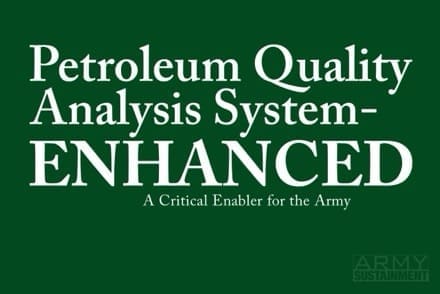
The Army uses the Petroleum Quality Analysis System-Enhanced (PQAS-E) for analyzing and assessing the quality of petroleum products consumed in military operations. The system is typically deployed and operated at echelons below brigade level. It serves as a critical enabling asset for commanders at the tactical level, supporting their decision-making processes related to petroleum. The PQAS-E encompasses a range of advanced apparatuses that can detect impurities and contaminants in petroleum, ensuring only high-quality fuel is used. It also offers the capability to monitor fuel storage conditions, such as temperature and humidity, to prevent degradation and ensure optimal performance.
In 2018, the 590th Quartermaster (QM) Detachment petroleum liaison received official endorsement from the Army Petroleum Center to oversee the inspection of PQAS-E correlation testing within the 18th Airborne Corps. This endorsement granted the 590th QM Detachment the necessary authority and responsibility to conduct thorough inspections and evaluations pertaining to the PQAS-E system, its operators, and its correlation-testing activities.
The primary objective of correlation testing is to verify the results obtained by the PQAS-E and ensure their alignment with established standards. As a petroleum liaison, the 590th QM Detachment plays a critical role in facilitating effective communication and coordination between the Army Petroleum Center, U.S. Army Tank-automotive and Armaments Command, U.S. Army Forces Command, and 18th Airborne Corps units. They provide technical expertise, guidance, and support to ensure accurate and efficient correlation testing of the PQAS-E.
Through many years of correlation inspections, the 590th QM Detachment has found the PQAS-E to be a critical asset for the Army. The system enhances operational readiness by ensuring military equipment receives optimal-quality fuel, thereby maximizing performance and minimizing the risk of equipment malfunctions. This leads to increased combat efficiency and mission success. The PQAS-E also reduces maintenance costs by preventing fuel-related issues that can lead to engine failures, equipment damage, and increased downtime. By eliminating the use of degraded or contaminated fuel, the PQAS-E significantly extends the lifespan of military assets, saving valuable resources.
Issues and Recommendations
The PQAS-E system, while highly advanced, faces certain apparatus issues that can impact its effectiveness. Specifically, the apparatuses that commonly experience failures are the Jet Fuel Thermal Oxidation Tester, the viscometer, the analytical balance scale, the 25kW generator, and the environmental control unit. Although the Army is currently investing in research and development efforts to improve the design and durability of apparatuses, the following recommendations may mitigate some of the common challenges with them.
Regular and proactive maintenance schedules should be established for all apparatuses in the PQAS-E. This includes routine inspection, cleaning, and calibration to identify and address any potential issues before they lead to complete failures. Additionally, implementing redundancy measures by having backup apparatuses readily available can minimize downtime and ensure continuous operation in the event of a failure. Furthermore, comprehensive training programs should be provided to operators and should include knowledge of supply functions, the ordering process, proper handling, and maintenance of the apparatuses.
To achieve the optimal system performance, there must also be engaged leaders at all echelons who can prioritize the readiness of this vital piece of equipment. This includes not only 923A Petroleum Systems Technicians, but also chains of command at the company, battalion, and brigade levels. Essential players such as supply, maintenance, and supply support activity personnel are also critical to the operational readiness rate of the PQAS-E. Key personnel must ensure inoperable equipment is documented and reported on the equipment status report. This information highlights the immediate issue at hand and demonstrates the potential risks and consequences of neglecting the system’s maintenance and repair. This increased visibility promotes a sense of accountability and drives action toward allocating necessary resources, prioritizing repairs, training, and ensuring the operational readiness of the system.
During deployment, it is crucial to have personnel who are knowledgeable about the supply chain and who can efficiently manage the inventory of spare parts and apparatuses. These personnel should be well-versed in the ordering process for replacements and repairs. Operators with a comprehensive understanding of supply functions can anticipate and plan for potential apparatus failures, ensuring non-mission-capable apparatuses are swiftly addressed and minimizing system downtime. By implementing these measures, the PQAS-E system can effectively overcome its apparatus issues and maintain its accuracy and reliability in analyzing fuel quality.
The deployment/redeployment of the system also presents a challenge related to certifications/shipping methods that should be carefully considered. One significant issue is ensuring the system is certified and compliant with transportation regulations and safety standards. This includes obtaining the necessary certifications and documentation to transport the apparatuses, fuel samples, and associated equipment safely and legally. The apparatuses and fuel samples require specialized packaging and handling to ensure their integrity and functionality upon arrival at the deployment location.
Failure to comply with these requirements can lead to delays, logistical complications, and potential legal issues. In the current operating environment, units must deploy with their PQAS-E labs. Effective planning is critical to the successful deployment of this system.
Conclusion
The PQAS-E, with its advanced apparatuses and capabilities, serves as a critical asset for the Army. By ensuring the use of high-quality fuel, the PQAS-E enhances operational readiness, reduces maintenance costs, and extends the lifespan of military assets. However, overcoming the current issues associated with the system’s apparatus is crucial for large-scale combat operations. With continuous improvement efforts and investment in research and development, the PQAS-E will continue serving as a key enabler for the Army, ensuring reliable fuel-quality analysis and supporting mission success.
——————–
Staff Sgt. Shanice Walker is a 92F Petroleum Supply Specialist currently assigned to the 590th Quartermaster Detachment petroleum liaison at Fort Stewart, Georgia, where she serves as a petroleum surveillance NCO. She holds a Bachelor of Science degree in information technology from American Military University, West Virginia, and is a graduate of the Advanced Leader Course, the Joint Petroleum Course, and the Defense Logistics Agency Energy Supply Chain Course.
——————–
This article was published in the Summer 2024 issue of Army Sustainment.

